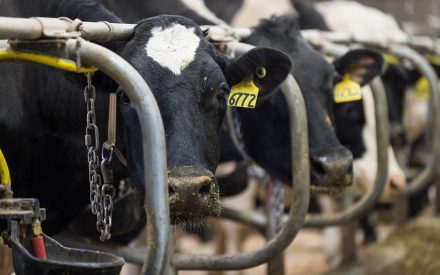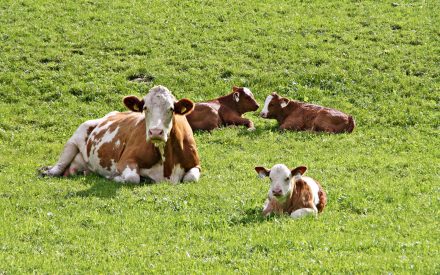What is corn silage?
Corn silage is a unique feed that combines high non-fiber carbohydrate (starch) and neutral detergent fiber (NDF). It does not feed strictly like a forage or a concentrate. Corn silage is also unique when looking at the NDF fraction of the feed. If corn silage is separated into its two primary portions—grain and non-grain (i.e., leaves and stem)—the non-grain portion is typically over 65% NDF. For NDF digestibility, measured as 30-hour NDFdigestibility (NDFd30) for corn silage harvested at 35% dry matter, half milk-line kernel development will range from 50% to 70%, which is higher on average than alfalfa-based hay or haylage. Unlike many high NDF feeds, corn silage is still favorable for fiber digestibility. Compared to byproducts that may have similar NDFd, corn silage, if processed correctly, is an excellent effective fiber source.
Why price corn silage?
If corn silage is grown to be sold, an agreed-upon price naturally is needed. However, much of it remains on farm and never exchanges ownership. Calculating a price may be needed to derive a value on a balance sheet. The price assigned to the corn silage will be a big factor in calculating how much it costs to feed a cow or replacement heifer.
How do you price corn silage?
There are many options for how to price corn silage that may affect evaluation of the livestock, dairy, crop, or farm system. Market price and cost of production are likely choices, but since the silage is often not sold, “market price” is an elusive number. Cost of production also can be difficult to estimate since the cost is different for corn used as grain versus corn silage. Here are some methods that can be used to effectively estimate corn silage pricing.
Cost of production (COP) method: COP is higher for corn silage than for corn used for grain. Harvest cost at comparable yield may run $120 per acre greater for corn silage (Wisconsin Custom Rate Guide 2020, Wisconsin Department of Agriculture, Trade, and
Consumer Protection). Corn silage at average yields will remove more P and K than grain: 25 and 145 pounds P2O5 and K2O respectively (Nutrient Management Fast Facts, Wisconsin Integrated Pest and Crop Management Program). In 2021, a high fertilizer input year, the value of extra removed nutrients exceeded $100 per acre. Benefits of silage include an earlier harvest window and no grain drying costs. COP will need to be recalculated if a crop is switched to silage from an intended grain use. After an accurate COP is estimated per acre, yield and margin required by the grower will complete the calculation of COP per ton. Shrink, and factors such as pricing a standing crop, a delivered crop, or a fermented crop, also must be considered.
Value based on alternative feeds: The UW–Madison Department of Animal & Dairy Sciences’s FeedVal 7.0 can account for variation in nutrient content (i.e., starch, starch digestibility, NDF, NDFd, and moisture). Forage test results, a current survey of alternative feedstuffs, their analysis, and price, are needed for a meaningful result from FeedVal 7.0. FeedVal 7.0 is especially important for estimating the value of corn silage hybrids not bred specifically for grain production. There are currently many hybrids on the market with claims of improved NDFd, starch digestibility, and fermentation characteristics.
The negotiated difference: In many instances the COP plus margin price will be lower than the value derived from FeedVal 7.0. In these cases, other factors can be used for negotiating the difference (e.g., delivered at harvest time, delivered continuously during the season, included in a completed TMR mix, etc.).
Sound complicated? Is there an easier method?
Thumb rules, such as using “X” factor (7 to 10) times the current bushel price of corn or using a percentage (25% to 33%) of the current price of hay to determine the price of corn silage, certainly can be simpler. These thumb rules may be a way to begin a conversation. At times when grain deviates from a normal range or forage is either abundant or practically non-existent, however, these thumb rules fail. The value of the two pools that provide value in corn silage, NDF and starch, are not always well correlated, creating the need to consider both fractions. Again, the thumb rules don’t account well for hybrids that have superior (or inferior) feeding characteristics such as starch digestibility or NDFd.
Additional resources:
- Buying and Selling Corn Silage: What’s a Fair Price?
- Corn Silage Pricing App (Apple App Store or Google Play Store)
- Corn Silage Pricing Webinar
- Tools for Pricing Standing Corn Silage
Developed by UW–Madison Extension Clark & Wood Counties Dairy Educator Matt Lippert for the 2022 Badger Dairy Insight Webinar Series: From Pricing to Feed Behavior, Februray 8, 2022.
Download Article

 Corn Silage Cutting Height Calculator – Background and Guide
Corn Silage Cutting Height Calculator – Background and Guide ▶️ Watch- Fresh Cows: Fetching the cow and blood money
▶️ Watch- Fresh Cows: Fetching the cow and blood money ▶️ Watch: Pregnancy Diagnosis in Dairy Cows using PAG Levels in Blood and Milk
▶️ Watch: Pregnancy Diagnosis in Dairy Cows using PAG Levels in Blood and Milk Hoof health & nutrition of dairy cows
Hoof health & nutrition of dairy cows


